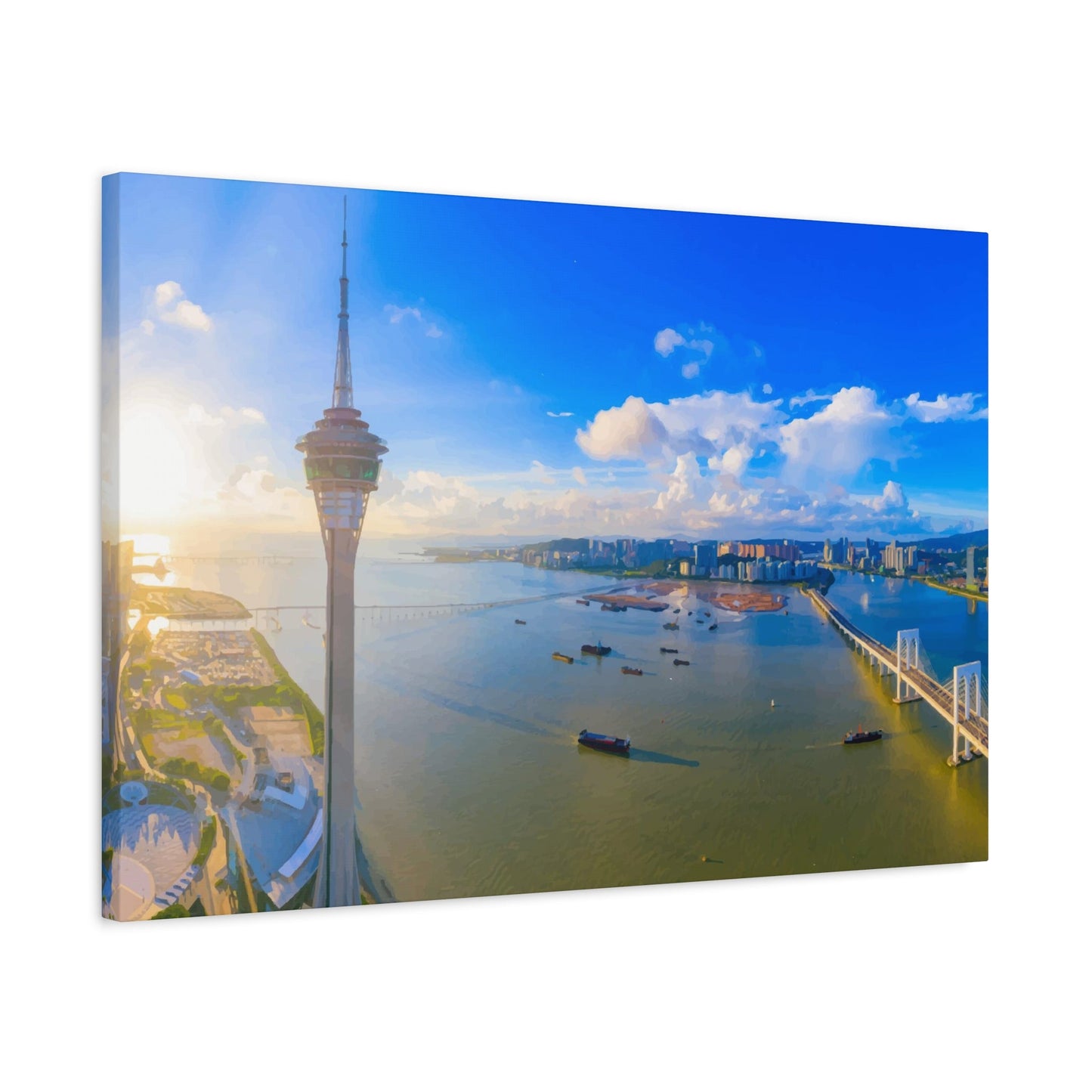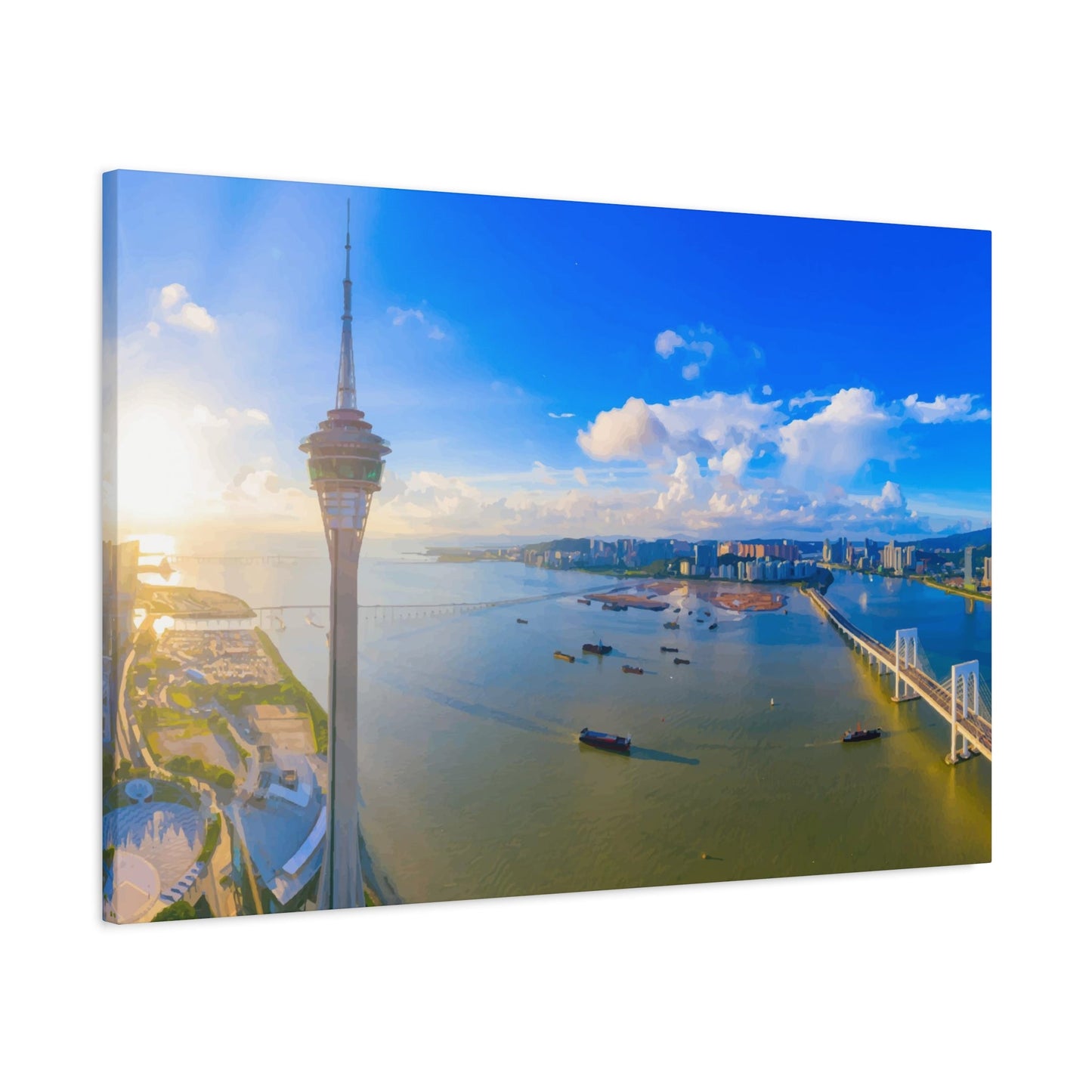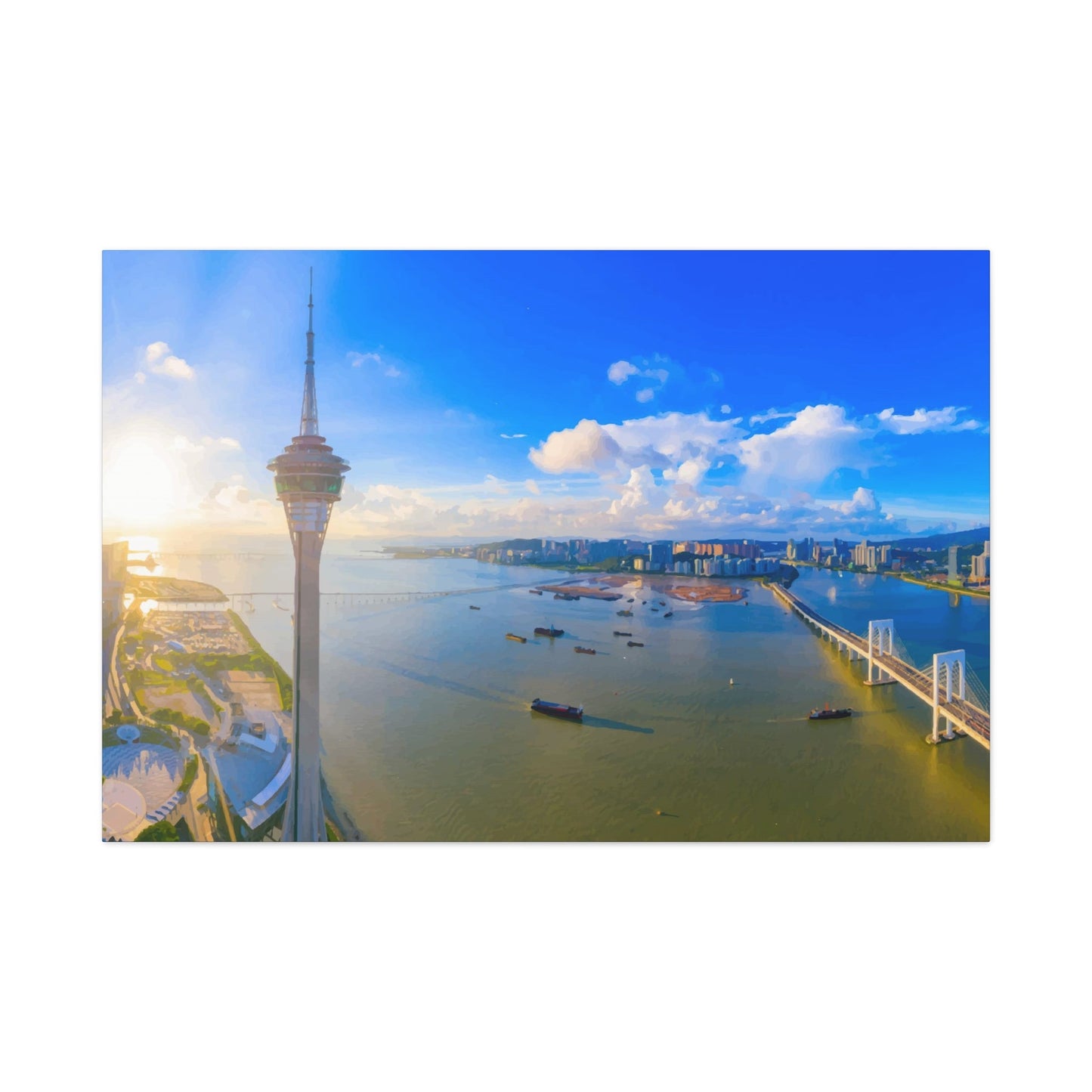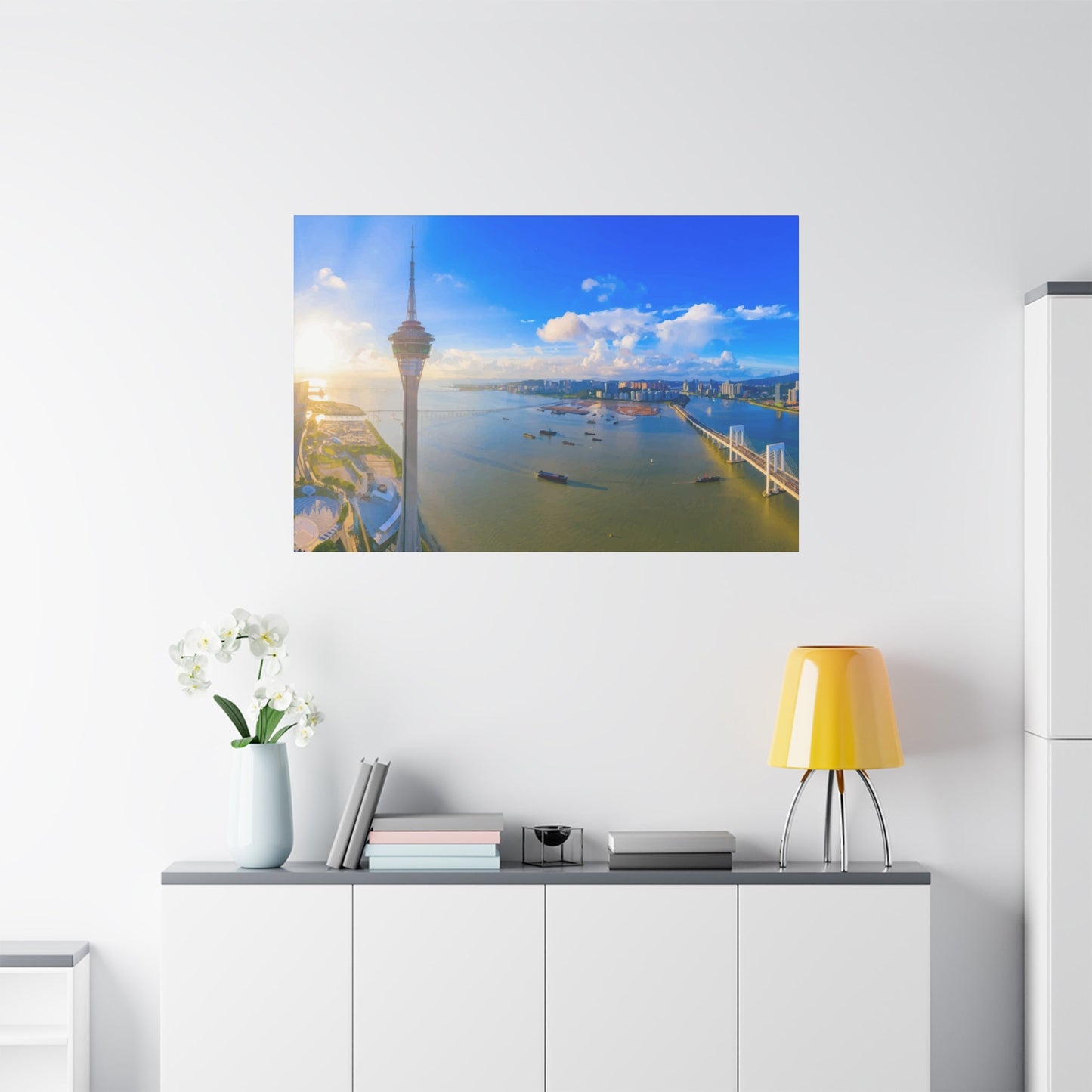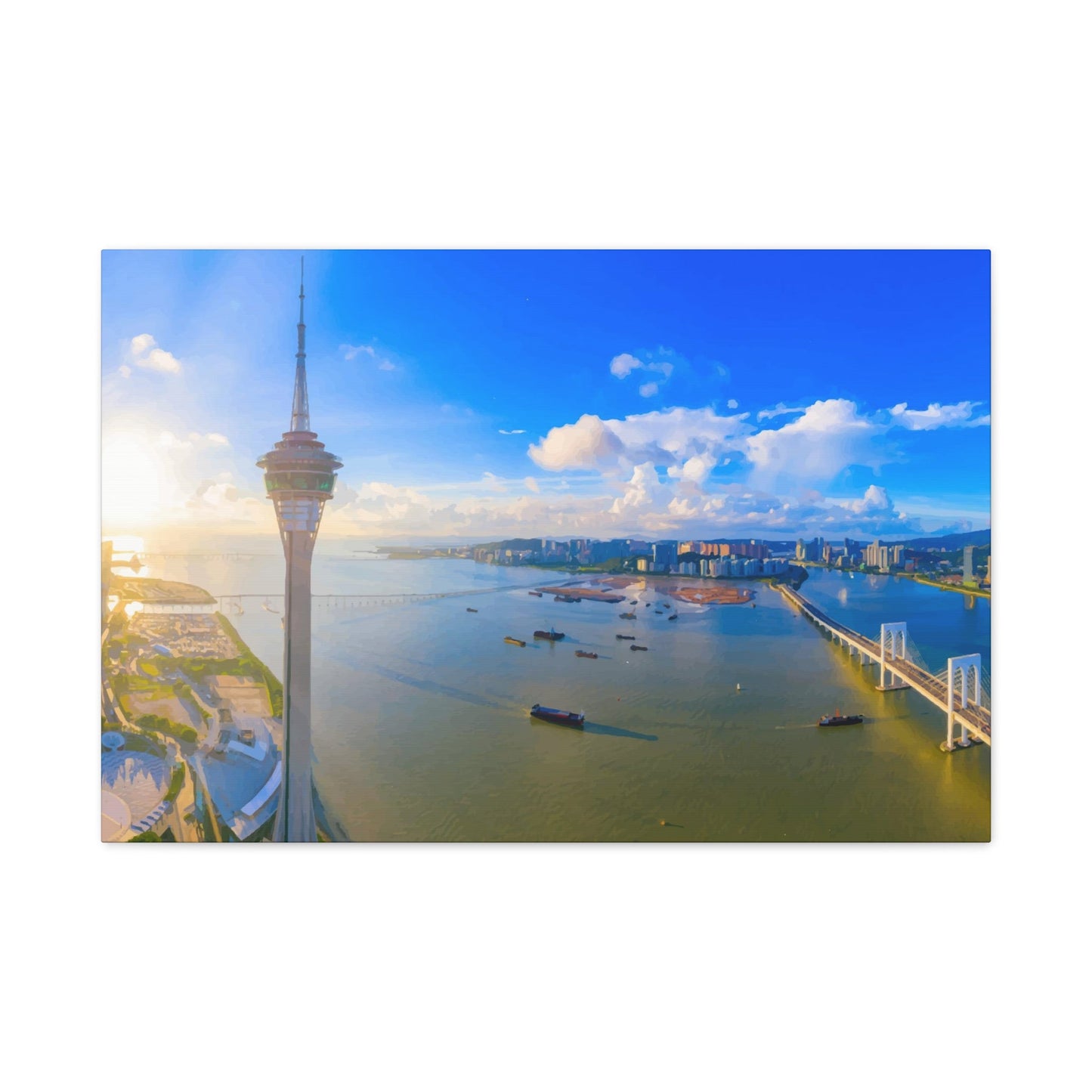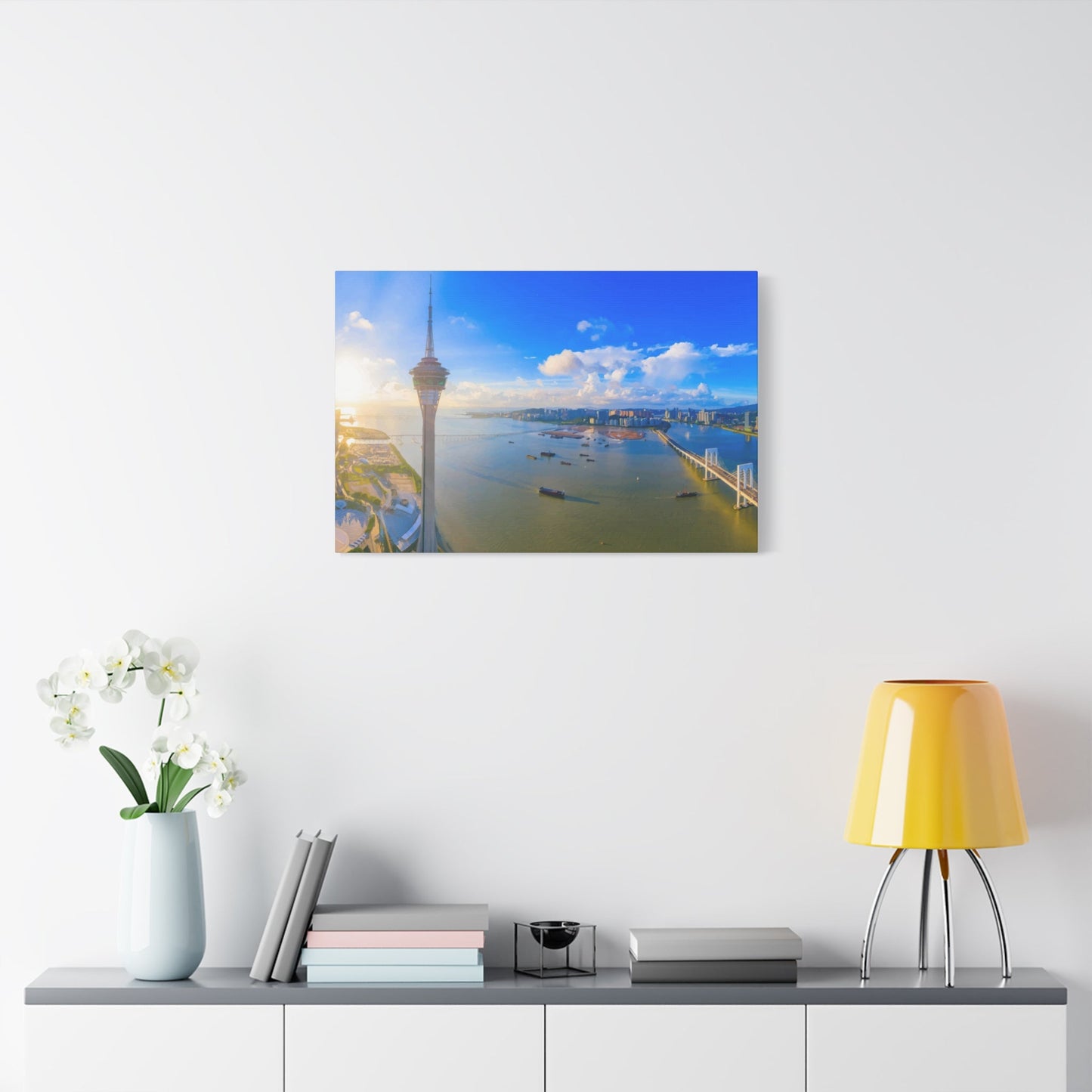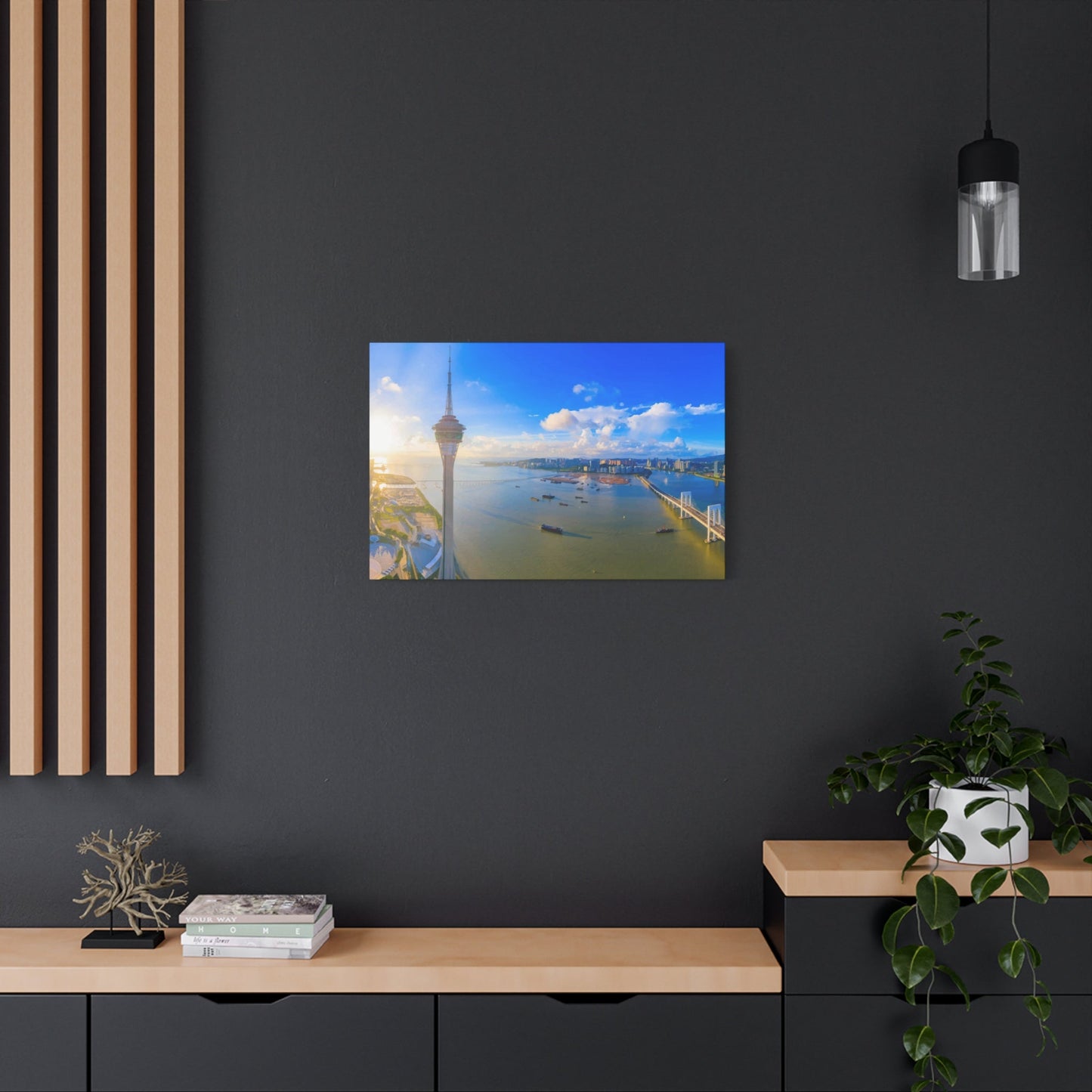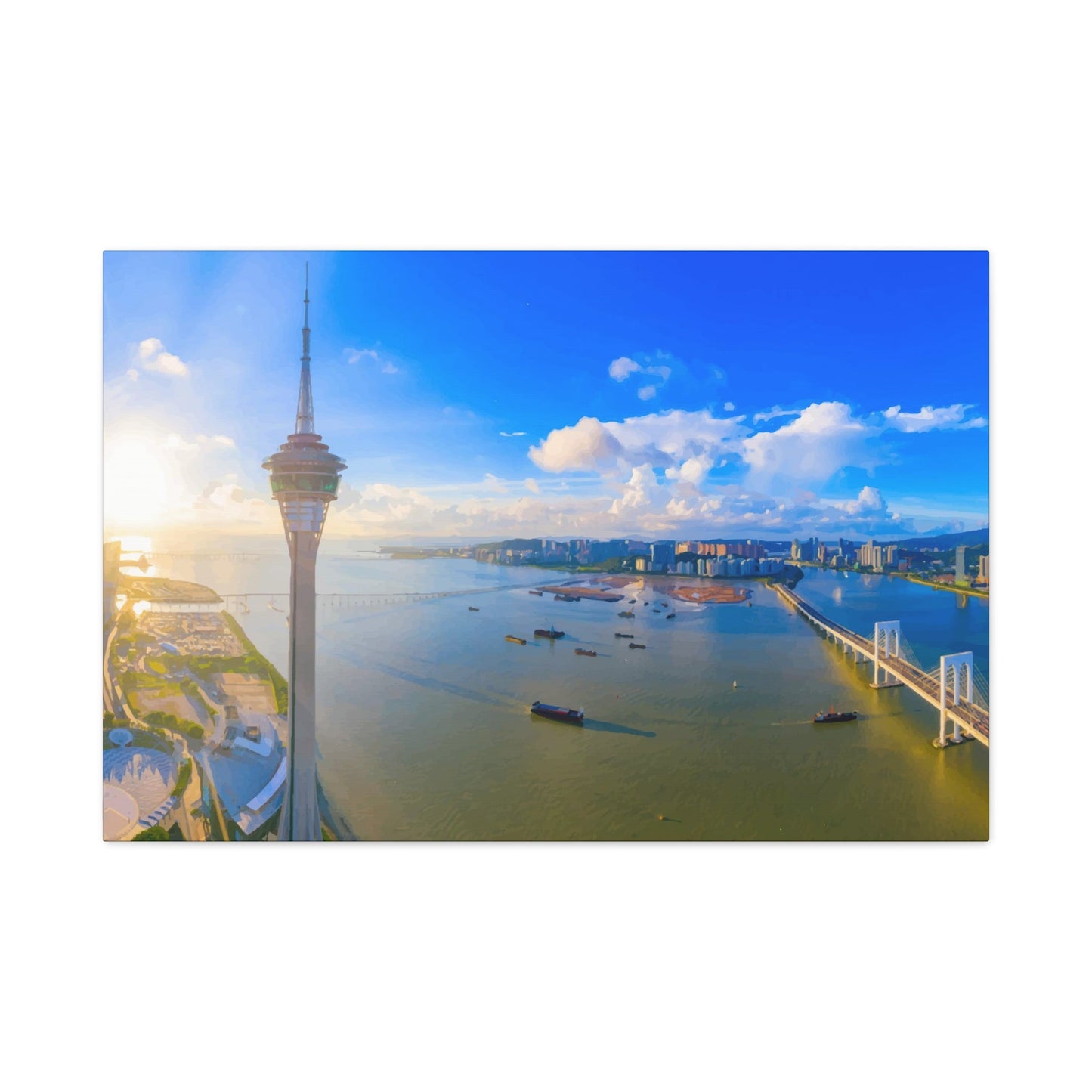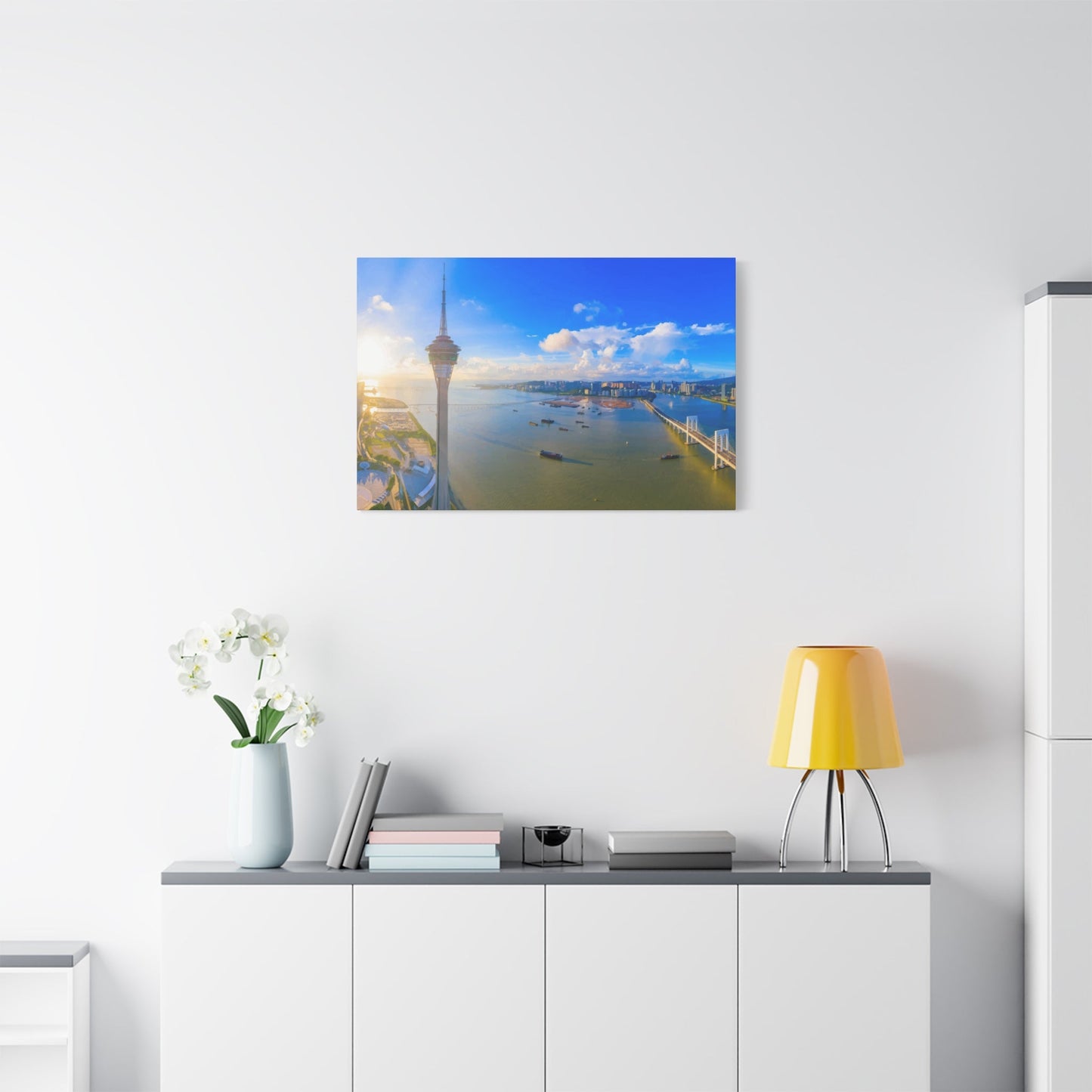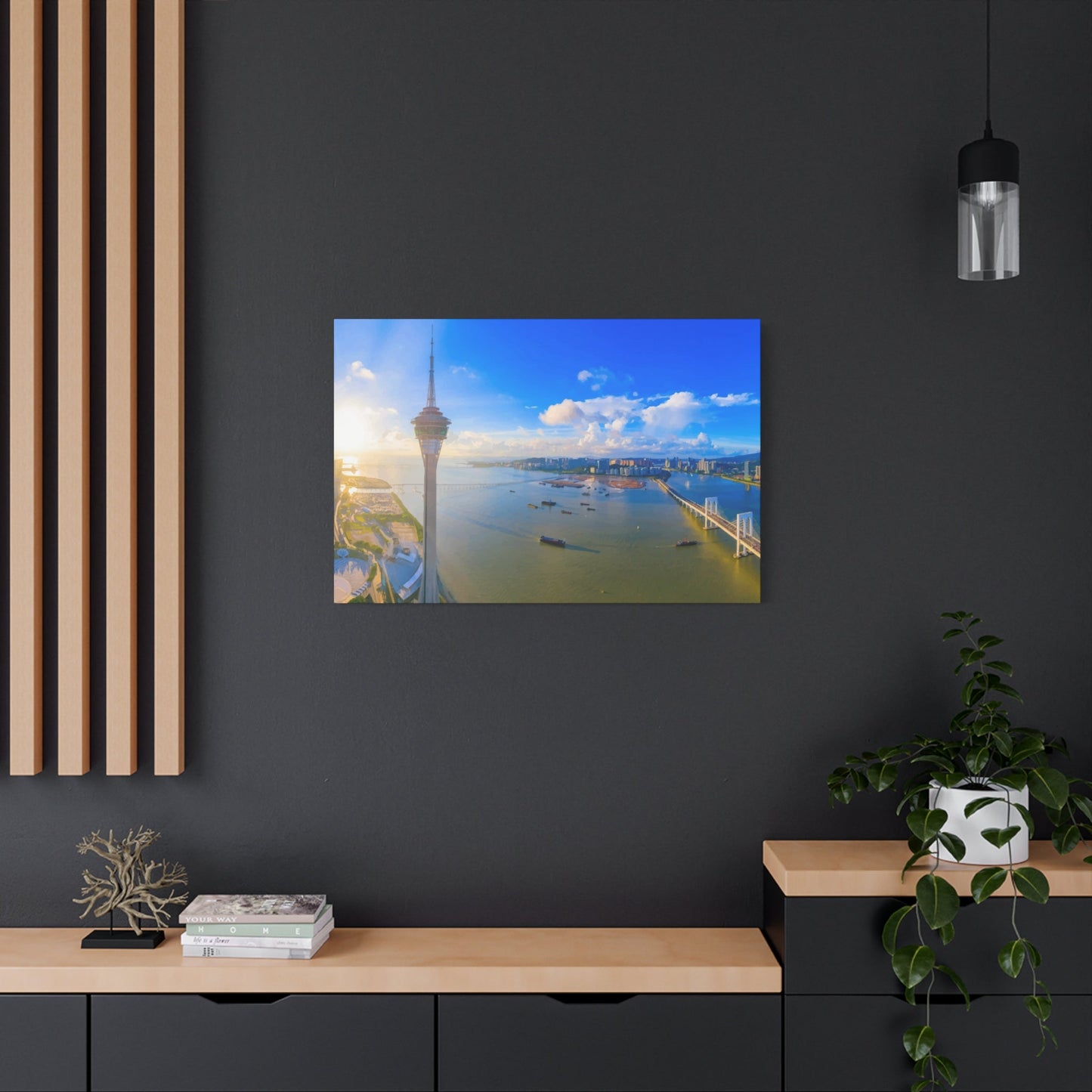Oceanic Interiors: How Sea View Wall Art Brings Coastal Serenity Into Your Living Space
The timeless allure of the ocean has captivated humanity for centuries, drawing us to its shores with promises of tranquility, adventure, and renewal. Today, you don't need to live by the coast to experience the calming presence of the sea in your daily life. Through carefully curated sea view artwork, you can transform any interior space into a coastal sanctuary that promotes relaxation, creativity, and emotional well-being. This comprehensive exploration delves into the art of incorporating oceanic vistas into your home, examining everything from psychological benefits to practical design strategies that will help you create a living environment that resonates with the peaceful energy of the water.
Breathe Easy with a Sea View
The concept of breathing easier with sea view artwork extends far beyond mere aesthetics. Scientific research has consistently demonstrated that exposure to natural imagery, particularly scenes featuring water, can significantly reduce stress hormones in the body and promote deeper, more rhythmic breathing patterns. When you position ocean-inspired artwork strategically throughout your living spaces, you create visual anchor points that encourage mindful breathing and present-moment awareness.
The therapeutic effects of gazing at ocean scenes can be traced to our evolutionary connection with water. Human settlements have historically developed near coastlines, rivers, and lakes, creating a deep-seated psychological association between water and safety, sustenance, and prosperity. This biological programming means that even representations of the sea can trigger relaxation responses in our nervous system, lowering blood pressure and heart rate while simultaneously increasing feelings of calm and contentment.
Interior designers and wellness experts increasingly recommend incorporating sea view prints in spaces where stress reduction is paramount. Home offices benefit enormously from the presence of coastal imagery, as these visuals provide the mind with brief respites during intense work sessions. The gentle movement suggested by wave patterns and the expansive horizons depicted in quality sea view art help counteract the tunnel vision and mental fatigue that often accompany prolonged screen time and concentrated cognitive tasks.
Bedrooms transformed with sea view artwork become sanctuaries of rest where the mind can transition smoothly from the demands of waking life into restorative sleep. The color palette typically associated with ocean scenes features blues, aquas, and soft greens that are scientifically proven to lower cortisol levels and prepare the body for rest. Positioning sea view art as the focal point opposite your bed creates a visual destination for your gaze each morning and evening, bookending your days with moments of tranquility and perspective.
Living areas adorned with sea view prints foster environments conducive to meaningful conversation and genuine relaxation. Unlike more stimulating artwork that demands attention or provokes strong reactions, ocean imagery creates a backdrop that soothes without sedating, energizes without overstimulating. This balanced quality makes sea view art particularly suitable for multi-functional spaces where various activities occur throughout the day. The presence of ocean vistas in these communal areas subtly reminds all occupants to slow down, breathe deeply, and appreciate the present moment rather than rushing anxiously toward future concerns.
The psychological mechanism behind the breathing benefits of sea view artwork involves the activation of the parasympathetic nervous system, which governs our rest and digest responses. When your visual field includes expansive ocean horizons, your peripheral vision picks up on the vastness and openness of the scene. This peripheral information signals to your brain that the environment is safe and spacious, allowing your breathing to deepen and slow naturally. Over time, regular exposure to these visual cues can actually retrain breathing patterns, helping individuals who tend toward shallow, anxious breathing to develop healthier respiratory habits.
Wall Art That Opens to the Ocean
Transforming solid walls into portals that seem to open directly onto oceanic vistas represents one of the most impactful design interventions you can make in any interior space. This approach goes beyond simply hanging a picture; it involves creating an immersive visual experience that fundamentally alters how you perceive and experience a room. Large-format sea view prints, particularly those featuring expansive horizons or dramatic coastal perspectives, can make small rooms feel substantially larger while simultaneously adding layers of depth and dimension to spacious areas.
The selection process for wall art that truly opens to the ocean requires careful consideration of several factors. The perspective captured in the photograph or artwork matters tremendously. Images shot from elevated vantage points looking out across the water create different psychological effects than beach-level views where the ocean rises to meet the sky. Elevated perspectives tend to evoke feelings of overview and control, making them excellent choices for spaces where decision-making and planning occur. Beach-level views, conversely, place the viewer in a more intimate relationship with the water, fostering contemplation and emotional connection.
Scale plays an equally critical role in creating the illusion of an opening to the ocean. Oversized prints that span significant portions of a wall break down the barrier between interior and imagined exterior far more effectively than smaller pieces. When a sea view print occupies enough visual real estate to engage your peripheral vision, your brain begins processing it not as a decorative object but as an actual window or portal. This perceptual shift amplifies all the psychological and emotional benefits associated with ocean exposure, creating a more profound impact on mood and well-being.
The frame selection and mounting technique further enhance or diminish this portal effect. Traditional heavy frames with ornate detailing can actually work against the illusion by drawing attention to the artifice of the image. Contemporary floating frames or frameless mounting systems that position the print slightly away from the wall create subtle shadows that enhance depth perception while minimizing visual interruption. Some design approaches eliminate frames entirely, allowing the printed canvas edges to wrap around stretcher bars, creating an object that reads more as an architectural element than a framed picture.
Lighting design dramatically influences how effectively wall art opens to the ocean within your space. Natural light sources positioned to illuminate sea view prints without creating glare can make the artwork seem to glow with its own internal light, further strengthening the window illusion. Strategic use of accent lighting, particularly LED strips concealed behind or around the print, can create a backlit effect that makes the ocean scene appear luminous and alive, especially impactful during evening hours when the contrast between darkened rooms and illuminated artwork becomes most pronounced.
Placement height critically affects the viewer's relationship with oceanic wall art. Hanging sea view prints at eye level when standing creates one type of engagement, while positioning them for optimal viewing from seated positions creates another. Bedrooms often benefit from slightly lower placement that aligns with sightlines from the bed, while living areas might call for positioning that works well from various seating arrangements. Some designers advocate for the horizon line within the artwork to align with actual eye level, creating a seamless extension of the viewer's perspective into the depicted scene.
Bring Coastal Calm to Your Home
Introducing coastal calm through sea view artwork involves more than selecting appealing images; it requires a holistic approach that considers how oceanic elements interact with your existing interior design scheme. The calming qualities associated with coastal environments stem from a combination of visual, associative, and symbolic factors that, when thoughtfully incorporated, can transform the entire emotional atmosphere of your home.
The color psychology of coastal calm centers on the blue-green spectrum that dominates healthy ocean environments. These hues activate specific neural pathways associated with openness, freedom, and tranquility. When sea view art introduces these tones into your interior color scheme, they work synergistically with other design elements to create cohesive spaces that feel intentionally peaceful rather than accidentally decorated. The key lies in balancing the cool tones of ocean imagery with warmer accents that prevent spaces from feeling cold or clinical.
Texture plays an equally important role in establishing coastal calm. While sea view prints obviously cannot provide literal texture, the textural qualities depicted within the artwork contribute significantly to the overall sensory experience. Images capturing the subtle ripples of calm waters evoke different feelings than those showcasing dramatic wave action. For maximum calming effect, select sea view prints that emphasize gentle movement, soft gradations of color, and harmonious compositions rather than turbulent, chaotic ocean states. These gentler representations maintain visual interest without introducing the anxiety that can accompany more dramatic seascapes.
The concept of coastal calm extends into the realm of negative space and visual breathing room. Ocean scenes inherently provide vast expanses of relatively uniform color and texture, offering the eye places to rest within the composition. This quality makes sea view art particularly valuable in contemporary homes where visual clutter from technology, collections, and daily life can create overstimulating environments. The simplicity and spaciousness of ocean horizons provide counterbalance, creating pockets of visual calm that allow the mind to decompress and reset.
Incorporating coastal calm through sea view artwork also involves considering the narrative and emotional qualities of specific images. Sunrise and sunset scenes over water carry different symbolic weight than midday vistas. Morning light on the ocean suggests new beginnings, fresh perspectives, and renewed energy, making these images ideal for spaces where you start your day or engage in creative work. Evening ocean scenes, with their associations of completion, reflection, and winding down, naturally complement bedrooms, reading nooks, and other spaces dedicated to rest and introspection.
The cumulative effect of thoughtfully selected sea view art throughout a home creates what designers call a throughline, a recurring visual theme that unifies disparate spaces and creates a sense of intentionality. This doesn't mean every room requires identical ocean imagery, but rather that complementary coastal elements appear in ways that create rhythm and flow as you move through the space. Perhaps the entryway features a dramatic seascape that sets the tone, while bedrooms showcase gentler, more intimate coastal moments, and living areas display expansive horizons that encourage gathering and connection.
Serene Sea Views in Every Frame
The quest for serenity through sea view artwork requires discerning selection criteria that go beyond superficial beauty to consider the deeper qualities that promote lasting calm. Not all ocean images possess equal capacity to soothe and center; some compositions, color treatments, and subject matters work more effectively than others to create the serene atmosphere most people seek when incorporating coastal imagery into their homes.
Compositional balance stands as perhaps the most critical factor in determining whether a sea view print will deliver sustained serenity. Images structured around the rule of thirds, where the horizon line falls approximately one-third from either the top or bottom of the frame, tend to feel more naturally peaceful than those with centered horizons. This asymmetrical balance creates visual interest while maintaining harmony, keeping the eye engaged without creating tension or discomfort. The positioning of the horizon also determines the emphasis between sky and water, each bringing distinct emotional qualities to the viewing experience.
Color saturation levels profoundly impact the serenity quotient of sea view artwork. Highly saturated, intensely vivid colors can actually stimulate rather than calm, making them less suitable for spaces where relaxation is the primary goal. More subdued, naturally toned ocean images that capture the subtle variations in blue, gray, and green found in actual marine environments typically deliver more sustainable serenity. These gentler color palettes integrate more easily with diverse interior design schemes while providing the visual rest that characterizes truly peaceful imagery.
The presence or absence of human elements within sea view compositions significantly affects their capacity to evoke serenity. Images of pristine, unpopulated coastlines tap into primal longings for untouched nature and solitary contemplation, often producing deeper calming effects than scenes including people, boats, or coastal development. However, strategically placed human elements can sometimes enhance rather than detract from serenity, particularly when they provide scale that emphasizes the ocean's vastness or when they depict peaceful activities like beachcombing or quiet observation that reinforce rather than contradict the mood of tranquility.
Weather conditions captured in sea view photography directly correlate with emotional response. Clear, calm days with gentle seas universally promote feelings of peace and stability. Overcast skies with flat, metallic waters can evoke introspective serenity, a more melancholic but equally valid form of calm suitable for contemplative spaces. Dramatic storm scenes, while visually stunning, generally work against serenity, introducing elements of tension and unpredictability that, while exciting, contradict the goal of creating peaceful environments. Selecting appropriate weather moods for different spaces allows you to fine-tune the emotional character of each room.
Time of day imbues sea view imagery with distinct energetic signatures. Dawn light creates anticipatory serenity, a quiet excitement before the day fully begins. Midday scenes often convey stability and presence, the fullness of being in the moment. Twilight images carry winding-down energy, perfect for spaces where you transition from activity to rest. Nighttime ocean scenes, rare but powerful, tap into mystery and depth, suitable for spaces where introspection and deep thought are valued. Matching these temporal qualities to room functions enhances the coherence between space and purpose.
A Window to the Water
Conceptualizing sea view artwork as windows to the water fundamentally changes how you approach both selection and placement. This framing transforms decorative objects into architectural elements that seemingly open solid walls to reveal aquatic vistas beyond. Achieving this perceptual transformation requires attention to numerous details that work together to suspend disbelief and create a convincing sense of connection to the ocean.
The illusion begins with appropriate scale relationships. Actual windows in residential settings typically range from three to six feet in width and height. Sea view prints approaching these dimensions automatically trigger window associations in viewer perception. When combined with proper positioning at realistic window heights, typically centered between three and five feet from the floor, the artwork begins functioning less as wall decoration and more as an architectural opening. This subtle perceptual shift carries psychological weight, making spaces feel more open and connected to the natural world.
Realism in imagery supports the window metaphor far more effectively than obviously artistic or heavily manipulated photographs. While abstract interpretations of the ocean have their place in interior design, they rarely create the convincing window effect that realistic sea views achieve. High-resolution photographs capturing accurate colors, natural lighting conditions, and believable perspectives maintain the illusion most successfully. The viewer's brain, constantly seeking to make sense of visual information, more readily accepts realistic ocean imagery as an actual view, thereby delivering more pronounced psychological and emotional benefits.
The treatment of edges and transitions between wall and artwork critically impacts window authenticity. In actual architecture, windows sit within frames that create clear boundaries between interior and exterior. Replicating this relationship with appropriate framing or mounting techniques strengthens the window metaphor. Shadow box frames that create physical depth between the wall surface and the image enhance the three-dimensional quality that real windows possess. Alternatively, edge lighting that creates a subtle glow around the perimeter of the artwork can suggest the presence of natural light coming through an opening, particularly effective during evening hours.
Spatial planning around your window to the water enhances the illusion and maximizes impact. Just as furniture arrangements in rooms with actual windows often orient toward those views, positioning seating to face your sea view artwork creates opportunities for contemplation and engagement. A comfortable chair positioned for optimal viewing transforms a corner of any room into a meditation spot or reading nook where the ocean view becomes a companion and source of inspiration. Side tables holding shells, driftwood, or other coastal objects further develop the connection between the artwork and physical reality.
Multiple windows to the water within a single space require careful coordination to maintain believability and avoid visual confusion. If incorporating several sea view prints in one room, they should ideally depict compatible scenes that could plausibly coexist in the same location. Mixing a Caribbean beach scene with a Pacific Northwest rocky coastline in the same sightline creates cognitive dissonance that undermines the window illusion. Instead, consider variations on a theme, perhaps different perspectives or times of day from the same coastal region, creating the impression of multiple windows looking out on a coherent environment.
Ocean Horizons for Tranquil Walls
Ocean horizon imagery holds unique power among sea view compositions due to the profound symbolic and psychological significance of horizons in human experience. The horizon represents boundaries between known and unknown, present and future, earth and sky. When you bring ocean horizons into interior spaces through artwork, you invite these symbolic associations along with the visual beauty, creating layers of meaning that resonate on both conscious and subconscious levels.
The mathematics of horizon lines in ocean photography influences viewer response in subtle but meaningful ways. Images where the horizon sits low in the frame, revealing expansive skies, tend to evoke feelings of possibility, aspiration, and spiritual connection. These compositions direct attention upward and outward, making them particularly suitable for spaces where creative thinking and strategic planning occur. Conversely, compositions emphasizing water over sky, with high horizon lines, ground the viewer's attention in the present moment and the tangible world, promoting focus and concrete action.
The quality of light at the horizon represents one of the most compelling aspects of ocean horizon photography. The atmospheric effects that occur where sky meets sea create spectacular color gradations, from the intense oranges and pinks of sunrise and sunset to the subtle lavenders and grays of overcast conditions. These transitional zones of color and light hold special fascination for the human eye, drawing and holding attention in ways that more uniform color fields cannot. This quality makes horizon-focused sea view art naturally compelling without being demanding, perfect for creating focal points that engage without overwhelming.
Horizon clarity varies dramatically depending on atmospheric conditions, and this variation carries emotional weight. Crystal-clear horizons with sharp delineation between sea and sky convey certainty, clarity, and order. These images work well in spaces where decisiveness and clear thinking are valued. Soft, blurred horizons where sea and sky merge imperceptibly evoke mystery, infinity, and the dissolution of boundaries. These hazier views excel in meditative spaces or environments dedicated to creative exploration where rigid thinking might hinder rather than help.
The complete absence of land in pure ocean horizon images creates a specific psychological effect worth considering. When the frame contains only water and sky, the image becomes about pure elements and elemental forces. This reduction to essentials strips away complexity and invites simplified thinking, making such images valuable in spaces where you seek to cut through confusion and return to fundamental truths. The minimalism inherent in ocean horizon compositions also allows them to integrate seamlessly with various design styles, from spare modernism to comfortable traditionalism.
Cultural and personal associations with horizons influence how ocean horizon art functions within your space. For some individuals, horizons represent freedom and possibility, the call to adventure beyond current circumstances. For others, they symbolize separation from something or someone distant, carrying melancholic undertones. Understanding your own relationship with horizon imagery helps you select pieces that resonate positively with your emotional landscape rather than inadvertently introducing uncomfortable associations. The goal is always to choose sea view art that enhances your well-being rather than creating subtle psychological discomfort.
Wake Up to the Sea, Every Day
Establishing a morning ritual of waking to sea views through bedroom artwork creates a powerful pattern that can influence your entire day. The bedroom environment holds special significance in overall well-being, as it brackets each day with experiences that set tones and create emotional contexts for everything that follows. When your first conscious moments each day include the sight of calming ocean imagery, you establish a baseline of tranquility that carries forward into subsequent activities and challenges.
The positioning of sea view artwork in bedrooms requires special consideration of sightlines from the bed itself. Unlike living areas where artwork might be viewed from multiple positions, bedroom art serves a primary audience of one or two people viewing from specific locations. Mounting sea view prints directly opposite the bed ensures they fall into your natural line of sight as you wake and again as you settle for sleep. This strategic placement transforms the artwork from decoration into functional tool for morning motivation and evening relaxation.
The specific ocean scenes you choose for bedroom display significantly impact sleep quality and morning mood. Turbulent seascapes with crashing waves, while dramatic and beautiful, introduce energy that may work against restful sleep for some individuals. Gentler scenes of calm waters, particularly those capturing the soft light of dawn or the peaceful moments after sunset, better support the transitional states between waking and sleeping. The goal is to select imagery that your subconscious mind interprets as safe and peaceful, allowing complete relaxation rather than maintaining vigilance against perceived threats.
Color temperature in bedroom sea view art deserves careful attention, as it directly affects circadian rhythms and sleep hormones. Cooler blue tones, while classically associated with ocean imagery, can actually promote wakefulness and alertness in ways that may interfere with sleep if too intense. Warmer blue-greens, aquamarines, and ocean scenes incorporating sunset colors create more sleep-friendly environments. Many people find that slightly desaturated ocean images, rather than intensely vivid ones, work best in bedrooms, providing visual interest and thematic coherence without overstimulation.
The psychological impact of waking to ocean views extends beyond immediate mood effects to influence long-term patterns of thought and behavior. Regular exposure to expansive natural imagery helps maintain perspective, reminding you of your place within larger systems and reducing the tendency to catastrophize daily stresses. Starting each day with this broader perspective sets a tone of proportion and balance that can make challenges feel more manageable and successes more meaningful. Over time, this daily visual reminder of natural beauty and persistence becomes internalized, shaping your fundamental outlook on life.
Creating a complete morning ritual around your bedroom sea view art amplifies its beneficial effects. Rather than simply glancing at the artwork as you rush to start your day, consider building in a few moments of intentional observation. Upon waking, while still in bed, spend one or two minutes actually looking at the ocean scene, noticing details you might have overlooked, allowing your breathing to deepen and synchronize with the implied rhythm of the waves. This brief practice costs almost nothing in time but pays substantial dividends in stress reduction and emotional centering that improve the quality of your entire day.
Escape Indoors with Sea View Prints
The concept of indoor escape through sea view prints addresses a fundamental tension in contemporary life, the disconnect between increasing amounts of time spent in constructed environments and the human need for connection with nature. While nothing fully replaces actual time outdoors near water, thoughtfully selected and positioned sea view artwork can provide meaningful surrogate experiences that deliver surprising psychological and physiological benefits.
The mechanism underlying successful indoor escape through imagery relates to the brain's processing of visual information. Neuroscience research reveals that viewing nature scenes, even in photograph form, activates many of the same neural pathways stimulated by actual nature exposure. While the effect is less intense than being physically present in natural environments, it remains significant enough to measure in terms of stress hormone reduction, improved mood markers, and enhanced cognitive function. Quality sea view prints essentially hack this system, providing accessible nature exposure regardless of geography, weather, or time constraints.
Creating effective escape experiences through sea view art requires attention to immersion factors. The more completely the artwork can engage your attention and imagination, the more effective the escape becomes. This argues for larger format prints that fill significant portions of your visual field, reducing awareness of surrounding constructed environments. It also suggests minimizing competing visual stimuli near your sea view artwork, allowing it to dominate the perceptual experience rather than fighting for attention among cluttered walls or overly busy design schemes.
The narrative quality within sea view prints influences their effectiveness as escape vehicles. Images that suggest stories or invite imaginative participation provide richer escape experiences than more static compositions. A deserted beach with a single set of footprints leading toward the water invites you to imagine walking that path. A distant sailboat on the horizon prompts speculation about destinations and journeys. These narrative elements engage the mind's creative faculties, pulling attention more completely away from immediate concerns and into the imagined space of the artwork.
Timing and intentionality transform casual glances at sea view art into genuine escape experiences. Simply having ocean imagery on your walls provides baseline benefits, but the greatest impact comes from intentional engagement. Building brief viewing breaks into your daily routine, perhaps five minutes of focused attention on your sea view prints during stressful work periods or transitional moments between activities, creates powerful reset opportunities. During these intentional viewing sessions, the goal is complete absorption in the image, noticing every detail, imagining sounds and sensations, and allowing yourself to mentally inhabit the depicted scene.
The escape potential of sea view prints extends beyond individual stress relief to support household harmony. Spaces designed to facilitate indoor escape become refuges where family members can retreat during conflicts or overwhelming moments. Designating a particular room or corner as a calm-down space, anchored by soothing sea view artwork, provides everyone in the household with a known destination for emotional regulation and perspective recovery. This shared resource supports healthier conflict resolution and emotional processing, particularly valuable in homes with children or during high-stress periods.
Let the Tide Inspire Your Decor
Using tidal imagery and oceanic rhythms as inspiration for comprehensive decorating schemes creates cohesive environments that feel intentional and harmonious. The tide serves as a powerful metaphor for natural cycles, constant change within reliable patterns, and the dance between opposites that characterizes healthy living. Translating these concepts into interior design through sea view artwork and complementary elements produces spaces that feel alive and dynamic rather than static and stale.
The color story of tidal zones provides a sophisticated palette for entire rooms or whole homes. The zone where sea meets shore features an ever-changing array of hues, from the deep blues of incoming waves to the foam whites of breaking surf, the warm sands of dry beach to the darker wet sands at the water's edge. Sea view artwork capturing these transitional zones can anchor a decorating scheme that incorporates all these tones throughout the space. Upholstery in sand tones, accent pillows in seafoam green, walls in soft gray-blue, and natural wood furniture in driftwood finishes all coordinate to create environments that feel cohesively coastal without resorting to obvious nautical clichés.
Texture variety inspired by tidal environments adds depth and interest to sea-themed interiors. The ocean's edge includes smooth water-polished stones, rough barnacle-encrusted rocks, soft sand, fibrous rope, and weathered wood. Translating these textures into interior elements creates tactile richness that prevents coastal spaces from feeling one-dimensional. Sea view artwork depicting various textures visually represents this variety, while physical elements throughout the space make it tangible. Nubby linen throws, smooth ceramic vases, rough jute rugs, and sleek glass accents work together to evoke the textural diversity of actual coastlines.
The rhythm of tides, that eternal cycle of advance and retreat, can inspire furniture arrangements and spatial flow. Rather than static, symmetrical layouts, consider more dynamic arrangements that suggest movement and change. Curved sectional sofas echo the curved shape of breaking waves. Furniture groupings that create alternating zones of gathering and retreat mirror tidal patterns of fullness and emptiness. Sea view artwork positioned to draw the eye through spaces suggests the pull of tides, encouraging natural circulation patterns that keep energy moving rather than stagnating.
Layering serves as a key principle in tide-inspired decorating, reflecting how tidal zones build up deposits of shells, stones, seaweed, and driftwood over time. Rather than minimal spaces with few objects, embrace curated collections that tell stories and reflect the accumulation of meaningful experiences. Display shells gathered from memorable beach walks, position weathered coral fragments as sculpture, arrange sea glass in clear vessels where light can illuminate it. Your sea view artwork becomes the backdrop for these three-dimensional coastal elements, creating depth and personality that generic hotel-style coastal decor lacks.
The concept of high and low tides can inform color intensity choices throughout the space. Just as tidal zones experience dramatic swings between exposure and submersion, your rooms can feature areas of intense color concentration alongside zones of relative restraint. Perhaps the sea view artwork serves as the high tide of color, with intense blues and dynamic contrast, while surrounding walls and furnishings stay in the low-tide zone of subtle, desaturated tones. This dynamic creates visual interest and prevents the monotony that can result from too-uniform color distribution.
Blue Tones, Peaceful Vibes
The psychological and physiological effects of blue tones in interior environments have been extensively studied, revealing powerful connections between this portion of the color spectrum and human well-being. Sea view artwork naturally introduces blues in their most appealing contexts, associated with vast skies, clean water, and pristine natural environments. Understanding how blue tones function psychologically allows you to leverage sea view prints more effectively in creating genuinely peaceful living spaces.
Blue light's impact on human biology stems from its influence on circadian rhythms and alertness. The cooler blue tones associated with midday light signal to our bodies that it is time for activity and focus. While this makes intense blues potentially counterproductive in bedrooms where relaxation is paramount, it suggests their value in workspaces and areas where mental clarity matters. Sea view prints featuring clear blue skies and bright water work well in home offices and study spaces, supporting concentration and cognitive performance. The key is balancing the alertness-promoting qualities of bright blues with sufficient warmth to prevent environments from feeling cold or clinical.
The depth and richness of ocean blues carries different psychological weight than the brighter blues of sky. Deep water blues, particularly those verging toward teal and navy, create feelings of stability, depth, and quiet strength. These darker blue tones work beautifully in spaces where you seek to feel grounded and secure, providing a sense of protective embrace rather than vast exposure. Sea view artwork featuring deep water in foreground elements combined with lighter blues in distant horizons creates pleasing depth while offering the stabilizing influence of darker tones balanced against the expansiveness of lighter shades.
Cultural associations with blue influence its emotional impact, though these associations remain remarkably consistent across diverse populations. Blue consistently ranks as the world's most popular color, transcending cultural boundaries with nearly universal positive associations. This makes blue-dominant sea view art a safe choice for creating peaceful environments that will resonate with most people regardless of personal color preferences or cultural background. The color's association with trust, reliability, and calm makes spaces featuring blue tones feel inherently safe and welcoming to visitors and inhabitants alike.
The saturation level of blues in sea view artwork dramatically affects their peaceful qualities. Highly saturated, vivid blues can actually stimulate rather than calm, creating visual excitement that works against peace in some contexts. The most peaceful blue tones typically show moderate saturation, capturing the naturalistic quality of actual ocean and sky while avoiding the artificiality of overly enhanced digital colors. When selecting sea view prints, consider viewing them under lighting conditions similar to those in your intended display location, as blues can shift dramatically in appearance depending on lighting quality and intensity.
Balancing blue tones with warmer accents prevents spaces from feeling emotionally cold despite their visual coolness. Sea view artwork that includes warm elements, perhaps sand in the foreground, sunset colors on clouds, or sun-warmed rocks along the shore, automatically provides this balance within the composition itself. When the artwork leans heavily toward pure blues without warm accents, compensate through surrounding design elements. Wood tones in frames or furniture, warm metallics like brass or copper in fixtures, and textiles in cream, tan, or warm gray tones create the temperature balance that makes blue-dominant spaces feel inviting rather than austere.
Framed Sea Views That Soothe
The framing choices you make for sea view artwork significantly impact both the aesthetic integration of the pieces within your space and their functional ability to deliver calming, soothing effects. Frames serve as transition zones between artwork and environment, and getting this transition right enhances the overall experience while poorly chosen frames can undermine even the most beautiful ocean imagery.
Traditional framing approaches emphasizing ornate profiles and heavy presence tend to work against the lightness and airiness that characterize the most soothing sea view presentations. Elaborate gold frames, while beautiful with certain artwork styles, can create visual weight that contradicts the ethereal quality of ocean horizons and coastal light. For maximum soothing effect, consider frames that recede from notice, allowing the artwork itself to dominate the visual experience. Thin profiles in matte finishes, simple wood frames in natural or whitewashed tones, or minimalist metal frames create boundaries without burden, defining the artwork without overwhelming it.
The color relationship between frame and artwork matters tremendously in creating cohesive, soothing presentations. Frames that pick up and echo colors present within the sea view print create harmony that satisfies the eye's desire for pattern and repetition. A frame in driftwood gray perfectly complements ocean imagery featuring stormy skies and slate-colored waters. Whitewashed frames enhance the fresh, clean feeling of bright beach scenes with abundant sky. The goal is creating color conversations between frame and image that feel intentional and considered rather than arbitrary or purely functional.
Matting decisions influence how the viewer's eye enters and experiences the artwork. Wide mats create breathing room around ocean imagery, enhancing the sense of space and openness that makes sea views soothing. The mat color traditionally defaults to white or off-white, which works beautifully with most sea view prints by maintaining brightness and preventing the frame from visually encroaching on the image. However, consider subtly colored mats that bridge between frame and artwork, perhaps a soft blue-gray that transitions smoothly from a weathered wood frame to a stormy seascape, creating visual flow that guides the eye comfortably into the composition.
The physical depth of framing affects the three-dimensionality and importance the framed piece commands within a space. Shallow frames keep artwork close to the wall, creating a more integrated, less prominent presence suitable when you want sea views to blend seamlessly into the environment. Shadow box frames that position the artwork an inch or more away from the wall create dramatic depth and presence, making the framed piece a clear focal point that commands attention. This increased dimensionality can actually enhance the soothing qualities of sea view art by strengthening the window illusion, making the ocean scene feel more like an actual opening to the outside world.
Glass choices in framing sea view artwork deserve consideration beyond simple protection. Standard glass creates reflections that can interfere with viewing, particularly problematic with ocean imagery where you want unobstructed, immersive visual access. Museum glass with anti-reflective coatings virtually disappears, creating the clearest possible view of the artwork regardless of lighting conditions. While more expensive than standard glazing, the investment pays dividends in viewing quality and the resulting enhancement of the soothing properties you seek from the artwork. For spaces with controlled lighting where reflections are less problematic, acrylic glazing offers a lighter-weight, shatter-resistant alternative to glass.
Nature's Beauty Captured in Canvas
Canvas prints of ocean imagery offer distinct advantages over traditional paper prints under glass, creating different aesthetic effects and practical benefits that suit certain spaces and design approaches particularly well. Understanding these distinctions helps you make informed choices about print substrates that align with your functional needs and design vision.
The texture inherent in canvas creates a painterly quality that lends ocean photography an artistic character distinct from the sharp precision of paper prints. This texture softens fine details while maintaining overall clarity, creating a dreamier, more impressionistic feeling that some people find more soothing than the crisp realism of glossy photo paper. The canvas weave becomes part of the artwork itself, adding a handcrafted quality that connects contemporary sea view prints to the long tradition of marine painting stretching back centuries.
Gallery-wrapped canvas prints, where the image continues around the edges of the stretcher bars, eliminate the need for traditional frames entirely. This frameless presentation creates exceptionally clean, contemporary installations that suit modern and minimalist interiors. The three-dimensional object of the stretched canvas stands away from the wall naturally, creating subtle shadows that add depth without requiring shadow box framing. This self-contained quality makes canvas prints easier to hang and rehang, supporting the natural evolution of interior spaces as tastes and needs change over time.
The durability advantages of canvas make it particularly suitable for spaces where artwork faces challenging conditions. Bathrooms, where humidity levels fluctuate dramatically, can damage paper prints even under glass, but properly sealed canvas prints withstand these conditions far better. High-traffic areas where accidental contact might occur also benefit from canvas durability; the flexible substrate proves more forgiving than glass-covered prints that risk shattering. Kitchens, hallways, and children's spaces all represent locations where canvas sea view prints deliver practical advantages alongside their aesthetic contributions.
Color rendering on canvas differs subtly from paper, with canvas generally producing slightly warmer, less saturated tones. This characteristic actually enhances the soothing qualities of ocean imagery for many viewers, creating a gentler, more organic color palette that feels less digital and more natural. The slight softening that occurs when printing on canvas can make ocean scenes feel more inviting and accessible, less like pristine photographs and more like places you could actually visit and inhabit.
The size possibilities with canvas prints enable truly impressive large-scale sea view installations. Canvas can be stretched across very large frames without the weight and fragility concerns that arise with equivalent sizes under glass. This scalability makes canvas the ideal choice for statement pieces, particularly in rooms with high ceilings or large wall expanses that require substantial artwork to maintain proper proportions. A six-foot wide canvas print of an ocean horizon creates dramatic impact impossible to achieve practically with framed prints under glass.
Your Wall's Gateway to the Ocean
Transforming a wall into a gateway to the ocean requires more than simply hanging a piece of artwork; it calls for a thoughtful approach that considers how the image interacts with the room, its inhabitants, and the mood you want to create. Ocean-themed wall art has the unique ability to transport viewers to distant shores, evoke the calming rhythm of waves, and bring the sense of vast openness and freedom that only the sea can inspire. When chosen and positioned thoughtfully, these prints become more than decoration—they act as a portal, a psychological window that expands the limits of your living space.
To create this effect, consider the scale and perspective of the artwork. Large-format prints or canvases with sweeping seascapes allow the viewer to feel immersed in the scene, as if standing on the edge of a cliff or sailing across open waters. Smaller, detailed pieces can be grouped to create a gallery wall that tells a narrative of the sea, from gentle shoreline waves to stormy horizons. The key is to make the artwork proportionate to the space so it feels intentional rather than accidental.
Color and lighting are equally important in transforming a wall into a maritime gateway. Ocean-inspired prints often feature soothing blues, soft turquoises, and sandy neutrals, which can complement or contrast with your room’s palette. Accent lighting, such as adjustable wall sconces or subtle LED strips, can bring out the depth of color in a canvas, mimicking the natural glint of sunlight on water. This thoughtful interplay between light and art enhances the illusion of looking through a window to another world.
Additionally, integrating texture and materials into the display can amplify the sensory experience. Canvases with slightly textured surfaces or mixed-media elements, like layered paint and resin, give the water a lifelike shimmer. Framing options—minimalist metal, rustic wood, or floating frames—can further reinforce the feeling of being at the seashore or aboard a coastal retreat.
Beyond aesthetics, ocean-themed wall art serves a functional purpose in your daily life. Studies show that images of water and nature can reduce stress, improve focus, and evoke a sense of tranquility. By carefully selecting scenes that resonate with you personally—a sunrise over the waves, a stormy horizon, or a calm lagoon—you’re designing a space that not only looks beautiful but also nurtures emotional well-being.
In essence, transforming your wall into a gateway to the ocean is about creating a connection between interior design and imagination. It invites the serenity and majesty of the sea into your everyday life, turning ordinary rooms into immersive escapes. With the right artwork, lighting, and placement, a wall is no longer just a boundary—it becomes a threshold to the calming, expansive world of the ocean.
Conclusion
Oceanic Interiors: How Sea View Wall Art Brings Coastal Serenity Into Your Living Space highlights the transformative power of nature-inspired décor in creating calm, inviting, and visually stunning interiors. Sea view wall art captures the vastness, tranquility, and beauty of the ocean, allowing homeowners to bring the soothing essence of coastal landscapes into their everyday living spaces. Whether featuring sweeping horizons, gentle waves, or vibrant sunsets, these artworks provide a serene escape, transforming walls into portals of relaxation and inspiration.
The appeal of sea view wall art lies in its ability to merge aesthetic beauty with emotional and psychological benefits. Coastal imagery evokes a sense of calm, reduces stress, and encourages mindfulness, making it ideal for bedrooms, living rooms, or home offices. The gentle blues, soft whites, and warm golden hues commonly found in ocean scenes create a soothing color palette that complements a wide range of interior styles—from minimalist modern spaces to bohemian or coastal-themed décor. These artworks not only enhance visual appeal but also foster a sense of balance and harmony within your home environment.
Versatility is a key advantage of sea view wall art. Large-scale canvases can dominate a living area, acting as a focal point that draws the eye and creates a sense of depth, while smaller framed prints can be grouped in galleries, offering subtle yet effective visual interest. Abstract interpretations of waves or aerial coastal perspectives provide modern and artistic options, allowing homeowners to adapt sea view imagery to both contemporary and classic interiors. Layering these prints with complementary décor elements, such as driftwood accents, nautical textiles, or natural fibers, reinforces the coastal aesthetic while enhancing texture and dimension.
Lighting plays a crucial role in maximizing the impact of ocean-inspired wall art. Natural light enhances the vibrancy of blues and greens, while soft accent lighting or directional spotlights highlights subtle textures and reflections. The interplay of light and shadow adds depth, making the ocean scenes feel immersive and alive, as though the sea itself is present in the room. Proper illumination ensures that the artwork captivates viewers, creating a dynamic yet calming visual experience.
Sea view wall art also carries symbolic significance. The ocean has long represented freedom, renewal, and emotional clarity. Incorporating these images into your interiors serves as a reminder to slow down, reflect, and embrace the serenity of nature, even in urban or indoor settings. Each glance at a sea view print can evoke feelings of peace, nostalgia, or inspiration, offering both decorative and emotional value.
Ultimately, Oceanic Interiors: How Sea View Wall Art Brings Coastal Serenity Into Your Living Space demonstrates the profound ability of thoughtfully chosen art to enhance both aesthetics and atmosphere. Sea view wall art transforms ordinary walls into visual sanctuaries, infusing rooms with calm, sophistication, and a connection to the natural world. By integrating oceanic imagery into your décor, you create spaces that inspire relaxation, mindfulness, and well-being, while reflecting a refined sense of style and coastal charm.













